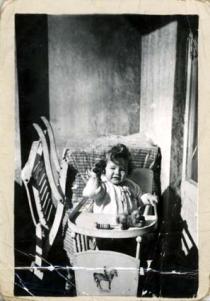The people you see in this photo are my father, my mother and me. It is a photo that was taken in Taksim Square [central Istanbul]. I think it was taken by one of the street photographers who took the picture and gave it to us immediately afterwards. My mother’s hat was a hat that was bought to go for a walk on Pera [today’s Istiklal Street that connects Tunel to Taksim] and I am wearing a coat that was sewn by a good dressmaker.
I was born in a neighborhood of Istanbul, called Ortakoy in 1929. I wasn't named after my paternal grandmother as was the tradition, but was named after my father's sister who had died at a very young age. [In the Sephardic tradition, the first girl born in the family is named after her father's mother, the first boy after his father's father, the second girl after her mother's mother, and the second boy after her mother's father] I'm the only daughter of this family. When I asked my mother about why I didn't have any siblings, she used to reply: "la situation ke ofre la Banco di Roma no permetiya de azer otra kreyatura" meaning "the financial rewards which Banco di Roma offered did not permit us to have another child". In the beginning I accepted this answer, but later on as I thought of even poorer families who had more children but who never starved and even went onto higher education, I decided that my mother was a little bit unfair. I even found my mother more unfair when I saw that my life style wasn't even close to being poor. My father, from time to time, received some bonus or shopping tickets from the bank. He brought home food which was called delicacy with these tickets. Some examples of the delicacy are: Likorinos, lakerda [salted fish varieties], Gruyere [yellow French cheese] and Roquefort cheese, kalamata olives, and canned sardines. But within the years, I sometimes thought "I'm lucky to have no siblings, taking care of this mother and father is my duty."
Not every household had radios in those times. Our neighbors had one in their house, and we would listen to the "children's hour" on Saturday mornings over at their house.
My family didn't travel much. We would go to the cinema once a week, and visit my mother's sisters, who lived in Tunel, once every 15 days. [a popular neighborhood in which the Jews lived] The way back home from Tunel was like a journey, during those days. Because my father liked walking very much, we would walk the distance between Tunel and Taksim [a central neighborhood], and Taksim and Dolmabahce [a neighborhood along the European side of the Bosphorus], and reach Ortakoy, by tram or bus.The distance between Tunel and Taksim, was the region where the most glamorous shops, the best restaurants, the passegeways, and the cinemas were located. The most luxurious goods were sold at the shops in these passegeways. Most of the shop owners were Levantines. The ladies would definitely go around wearing a hat in this region called Pera. We wore special hats when we went to the cinemas. We used them as accessories, not for keeping our heads warm. One of the most famous restaurants of Pera was "Regence", which was run by Russian ladies. The most famous dish of the restaurant was Borscht . The women who did the service would carry on with their own traditions by wearing long, and embroidered dresses. The most famous "patisseries" [bakery] of Pera, were the "Markiz" and "Lebon". Also, the "Inci patisserie", was famous for its "profiterol". As Dolmabahce was situated by the sea it was a pleasure to walk down the slope from Taksim to Dolmabahce and enjoy the sea view.































